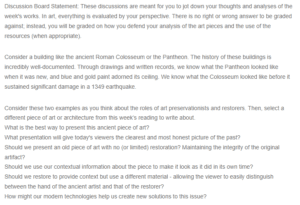Art Restoration – Portrait of Terentius Neo and his Wife
My choice of art for this assignment is a private portrait known as the Portrait of Terentius Neo and his wife (Kleiner, 2015). I believe the best way to present this ancient piece of art would be to frame it like the Mona Lisa. A presentation that avoids romanticism and instead brings forth realism is the best way to give audiences the most authentic and unblemished picture of the past. According to Fried & Menzel (2002), realism art embodies the world as accurately as possible, especially the ugly and harsh reality of the time.
When it comes to the restoration of art, I believe it should be done in particularly extreme cases. Such cases include when the art piece makes no sense on its own because it’s degraded or the art is falling apart and needs something to hold it together for preservation. Therefore, unless a piece of art is under such extreme circumstances, I believe restoration is unnecessary, and its integrity should be maintained. Contextual information should only be used to create another model of what the art looked like, for example, using 3D printing. Contextual information should be used to restore original art pieces because it might be wrong, which then ruins the art. Instead, it should be used to create models that give a general idea of the original artwork.
As mentioned before, art can be restored to provide context, especially in cases where a piece is too degraded and makes no sense on its own. I also believe the restoration should be done using different materials to help distinguish the original ancient artists from the restorer. Today, numerous modern technologies can help restore art or give context to what the art piece looked like in the past without altering the art in any way. Such technologies include 3D printing, which points to the exact replicas of the art. Another technology is holographs, which can also be used to project a realistic image of art (Bjelkhagen & Osanlou, 2011; Markov, 2011).
References
Bjelkhagen, H. I., & Osanlou, A. (2011). Color holography for museums: bringing the artifacts back to the people. In Practical holography XXV: materials and applications (Vol. 7957, pp. 82-88). SPIE.
Fried, M., & Menzel, A. (2002). Menzel’s realism: Art and embodiment in nineteenth-century Berlin.
Kleiner, F. S. (2015). Gardner’s art through the ages: A global history. Cengage Learning.
Markov, V. B. (2011). Holography in museums. The Imaging Science Journal, 59(2), 66-74.
ORDER A PLAGIARISM-FREE PAPER HERE
We’ll write everything from scratch
Question
Discussion Board Statement: These discussions are meant for you to jot down your thoughts and analyses of the week’s works. In art, everything is evaluated by your perspective. There is no right or wrong answer to be graded against; instead, you will be graded on how you defend your analysis of the art pieces and the use of the resources (when appropriate).

Art Restoration – Portrait of Terentius Neo and his Wife
Consider a building like the ancient Roman Colosseum or the Pantheon. The history of these buildings is incredibly well-documented. Through drawings and written records, we know what the Pantheon looked like when it was new, and blue and gold paint adorned its ceiling. We know what the Colosseum looked like before it sustained significant damage in a 1349 earthquake.
Consider these two examples as you think about the roles of art preservationists and restorers. Then, select a different piece of art or architecture from this week’s reading to write about.
What is the best way to present this ancient piece of art?
What presentation will give today’s viewers the clearest and most honest picture of the past?
Should we present an old piece of art with no (or limited) restoration? Maintaining the integrity of the original artifact?
Should we use our contextual information about the piece to make it look as it did in its own time?
Should we restore to provide context but use a different material – allowing the viewer to easily distinguish between the hand of the ancient artist and that of the restorer?
How might our modern technologies help us create new solutions to this issue?

